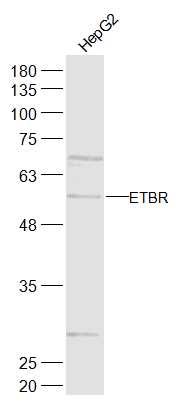
Rabbit Anti-ETBR antibody
ABCDS; Ednra; Ednrb; EDNRB_HUMAN; Endothelin B receptor; Endothelin B receptor precursor; Endothelin receptor Non selective type; Endothelin receptor non-selective type; Endothelin receptor type B; ET B; ET-B; ET-BR; ETB; ETRB; Hirschsprung disease 2; HSC
View History [Clear]
Details
Product Name ETBR Chinese Name 内皮素B受体抗体 Alias ABCDS; Ednra; Ednrb; EDNRB_HUMAN; Endothelin B receptor; Endothelin B receptor precursor; Endothelin receptor Non selective type; Endothelin receptor non-selective type; Endothelin receptor type B; ET B; ET-B; ET-BR; ETB; ETRB; Hirschsprung disease 2; HSCR; HSCR2; EDNRB; HSCR; WS4A. literatures Research Area Cardiovascular immunology Neurobiology Growth factors and hormones Immunogen Species Rabbit Clonality Polyclonal React Species Human, (predicted: Mouse, Rat, Chicken, Dog, Pig, Cow, Horse, Rabbit, ) Applications WB=1:500-2000 ELISA=1:5000-10000 IHC-P=1:100-500 IHC-F=1:100-500 IF=1:100-500 (Paraffin sections need antigen repair)
not yet tested in other applications.
optimal dilutions/concentrations should be determined by the end user.Theoretical molecular weight 50kDa Cellular localization The cell membrane Form Liquid Concentration 1mg/ml immunogen KLH conjugated synthetic peptide derived from human EDNRB: 31-130/442 <Extracellular> Lsotype IgG Purification affinity purified by Protein A Buffer Solution 0.01M TBS(pH7.4) with 1% BSA, 0.03% Proclin300 and 50% Glycerol. Storage Shipped at 4℃. Store at -20 °C for one year. Avoid repeated freeze/thaw cycles. Attention This product as supplied is intended for research use only, not for use in human, therapeutic or diagnostic applications. PubMed PubMed Product Detail Endothelin receptor type B (ETRB) is a G protein-coupled receptor that activates a phosphatidylinoitol-calcium second messenger system. Its ligand, endothelin, consists of a family of three potent vasoactive peptides: ET1, ET2, and ET3. A splice variant (SVR), differing in the intracellular C terminal domain, has been described for this receptor. Both WT and the variant bind ET1. However, they exhibit different responses upon binding - suggesting that these two variants are functionally distinct.
Function:
Non-specific receptor for endothelin 1, 2, and 3. Mediates its action by association with G proteins that activate a phosphatidylinositol-calcium second messenger system.
Subcellular Location:
Cell membrane; Multi-pass membrane protein.
Tissue Specificity:
Expressed in placental stem villi vessels, but not in cultured placental villi smooth muscle cells.
Post-translational modifications:
Palmitoylation of Cys-402 was confirmed by the palmitoylation of Cys-402 in a deletion mutant lacking both Cys-403 and Cys-405.
DISEASE:
Defects in EDNRB are a cause of Waardenburg syndrome type 4A (WS4A) [MIM:277580]; also known as Waardenburg-Shah syndrome. WS4A is characterized by the association of Waardenburg features (depigmentation and deafness) and the absence of enteric ganglia in the distal part of the intestine (Hirschsprung disease).
Defects in EDNRB are the cause of Hirschsprung disease type 2 (HSCR2) [MIM:600155]; also known as aganglionic megacolon (MGC). HSCR2 is a congenital disorder characterized by absence of enteric ganglia along a variable length of the intestine. It is the most common cause of congenital intestinal obstruction. Early symptoms range from complete acute neonatal obstruction, characterized by vomiting, abdominal distention and failure to pass stool, to chronic constipation in the older child.
Defects in EDNRB are the cause of ABCD syndrome (ABCDS) [MIM:600501]. ABCD syndrome is an autosomal recessive syndrome characterized by albinism, black lock at temporal occipital region, bilateral deafness, aganglionosis of the large intestine and total absence of neurocytes and nerve fibers in the small intestine.
Similarity:
Belongs to the G-protein coupled receptor 1 family. Endothelin receptor subfamily. EDNRB sub-subfamily.
SWISS:
P24530
Gene ID:
1910
Database links:Entrez Gene: 408082 Chicken
Entrez Gene: 1910 Human
Entrez Gene: 13618 Mouse
Entrez Gene: 100009477 Rabbit
Omim: 131244 Human
SwissProt: P24530 Human
SwissProt: P48302 Mouse
SwissProt: Q9N0W7 Rabbit
Unigene: 487 Cow
Unigene: 82002 Human
Unigene: 229532 Mouse
Unigene: 27603 Pig
Unigene: 6857 Rabbit
Unigene: 11412 Rat
Product Picture
References (0)
No References
Bought notes(bought amounts latest0)
No one bought this product
User Comment(Total0User Comment Num)
- No comment



 +86 571 56623320
+86 571 56623320
 +86 18668110335
+86 18668110335

